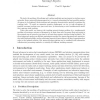Free Online Productivity Tools
i2Speak
i2Symbol
i2OCR
iTex2Img
iWeb2Print
iWeb2Shot
i2Type
iPdf2Split
iPdf2Merge
i2Bopomofo
i2Arabic
i2Style
i2Image
i2PDF
iLatex2Rtf
Sci2ools
138
click to vote
ALGOSENSORS
2007
Springer
2007
Springer
Efficient Sensor Network Design for Continuous Monitoring of Moving Objects
We study the problem of localizing and tracking multiple moving targets in wireless sensor networks, from a network design perspective i.e. towards estimating the least possible number of sensors to be deployed, their positions and operation characteristics needed to perform the tracking task. To avoid an expensive massive deployment, we try to take advantage of possible coverage overlaps over space and time, by introducing a novel combinatorial model that captures such overlaps. is model, we abstract the tracking network design problem by a combinatorial problem of covering a universe of elements by at least three sets (to ensure that each point in the network area is covered at any time by at least three sensors, and thus being localized). We then design and analyze an efficient approximate method for sensor placement and operation, that with high probability and in polynomial expected time achieves a (log n) approximation ratio to the optimal solution. Our network design solution c...
ALGOSENSORS 2007 | Network Design | Possible Coverage Overlaps | Sensor Networks | Tracking Network Design |
Related Content
| Added | 12 Aug 2010 |
| Updated | 12 Aug 2010 |
| Type | Conference |
| Year | 2007 |
| Where | ALGOSENSORS |
| Authors | Sotiris E. Nikoletseas, Paul G. Spirakis |
Comments (0)

